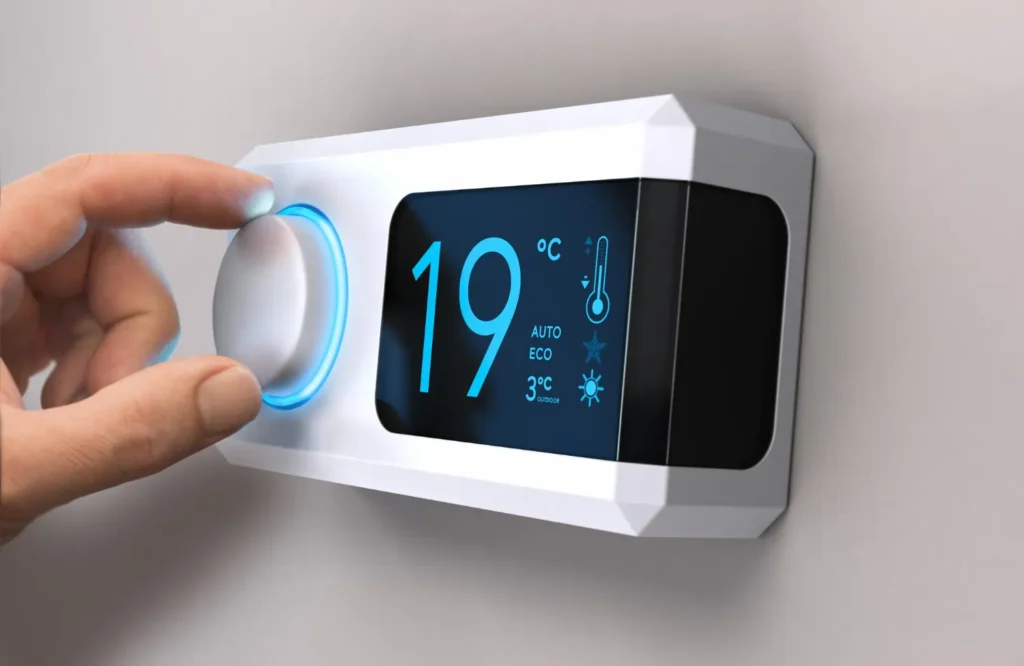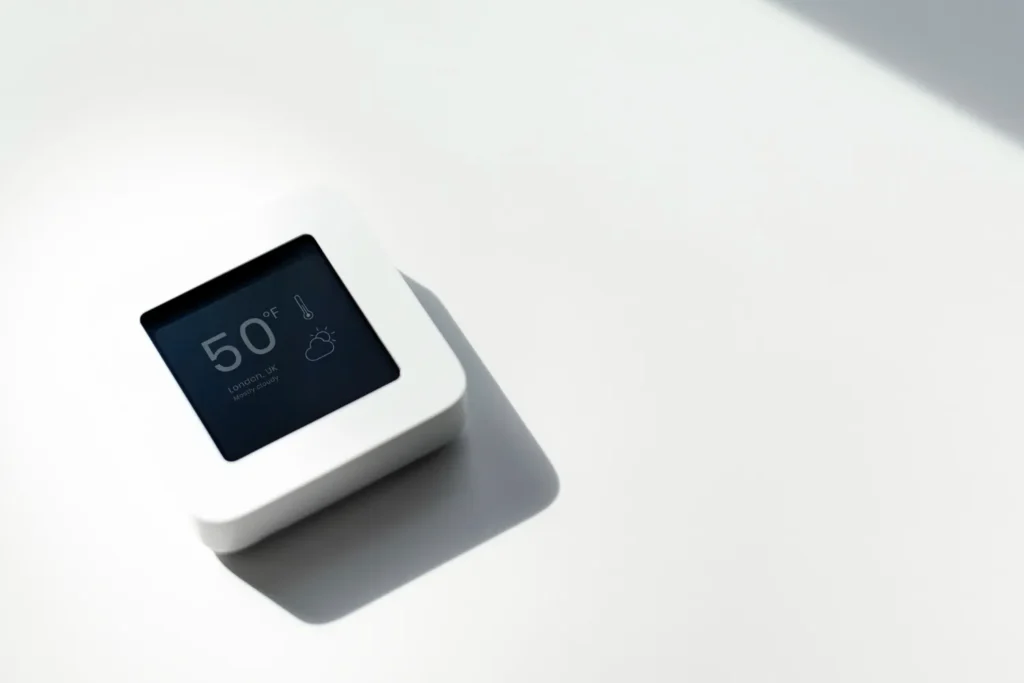Digital thermostats are a staple in modern homes and businesses, offering precise temperature control at the touch of a button. However, analog thermostats still have their place and require careful calibration to ensure optimal performance. Thermostat calibration is crucial to maintaining a comfortable and safe environment, whether at home or in a commercial setting. Inaccurate thermostats can lead to inefficient heating or cooling, discomfort, and potential safety hazards.
Regarding calibrating digital vs analog thermostats, it’s imperative to understand the differences in the process and know when and how to adjust each type effectively. This guide explores the steps for calibrating digital and analog thermostats, highlighting key points to ensure your heating and cooling systems operate at their best.
Key Takeaways:
- Digital vs Analog Thermostats: Regarding calibration, bimetallic analog thermometers typically require manual adjustment using a calibration nut, while digital thermometers may have a reset button for calibration.
- Calibration Frequency: Bimetallic analog thermometers should be calibrated before every shift, while digital thermometers should be calibrated weekly or monthly to ensure accuracy.
- Manufacturer’s Instructions: It’s crucial to follow the manufacturer’s specific instructions for calibrating digital and analog thermometers to maintain accuracy and food safety in a commercial kitchen setting.
Understanding Thermostats

It is essential to understand how thermostats work to calibrate them effectively and clearly. Thermostats are crucial in maintaining the desired temperature in various settings, such as commercial kitchens where food safety is paramount. In general, thermostats detect temperature changes and signal the heating or cooling system to adjust accordingly.
Digital Thermostats – Advantages and Operation
While digital thermostats offer precise temperature control and are often easier to read, they require regular calibration to ensure accuracy. These thermostats use electronic sensors to measure temperature, providing quick and reliable readings. The calibration of digital thermostats typically involves resetting the device according to manufacturer instructions to ensure that it remains accurate in critical temperature zones.
Analog Thermostats – Characteristics and Mechanisms
Less precise than their digital counterparts, analog thermostats are still commonly used in many settings. Analog thermostats operate using bimetallic mechanisms that expand and contract with temperature changes, indicating the current temperature. Despite their simplicity, analog thermostats require frequent calibration to maintain accuracy and prevent potential safety hazards in temperature-sensitive environments.
Another critical point to consider when dealing with analog thermostats is the need for manual adjustment using a calibration nut. This process may require tools like pliers or a wrench to ensure the thermostat accurately reflects the proper temperature. Regular calibration of analog thermostats is necessary to prevent deviations that could lead to inefficient heating or cooling, posing risks of spoilage or contamination.
Preliminary Steps for Thermostat Calibration
If you’re planning to calibrate your thermostat, some preliminary steps must be considered to ensure a successful and accurate calibration process.
Safety Tips and Precautions
One of the first things you should do before starting the calibration process is to ensure your safety. Wear protective gear such as gloves and safety glasses to prevent injuries. Also, disconnect the power source before handling any electrical components to avoid any electrical shocks. Remember to read the manufacturer’s instructions carefully and follow all proper safety precautions.
- Wear protective gear to avoid injuries.
- Disconnect the power source before handling electrical components.
- Read and follow the manufacturer’s instructions for safety.
This ensures a safe and efficient calibration process while preventing any potential risks.
Tools and Materials Needed
Steps:
A crucial aspect of preparing for thermostat calibration is gathering the necessary tools and materials needed for the process. Some vital items you will need include a screwdriver, a multi-meter, and the thermostat manual. These tools are essential for accurately accessing and adjusting the internal components of the thermostat.
One step that can help significantly in accurately calibrating thermostats is ensuring you have the right tools and materials. The screwdriver is vital for opening the thermostat casing and revealing the internal components. The multimeter is used to measure the current output of the thermostat, allowing you to adjust it to the desired temperature accurately. The thermostat manual is indispensable for referring to the manufacturer’s instructions and guidelines throughout the calibration process.
How-to Guide: Calibrating Digital Thermostats
Identifying Calibration Features
Clearly, before beginning the calibration process, it is imperative to identify the calibration features of your digital thermostat. Some digital thermostats have a reset button, while others may require adjustments through specific controls or settings. Understanding how to access and utilize these features is crucial for successful calibration.
Step-by-Step Digital Calibration Process
| Features | Process |
|---|---|
| Identify Calibration Features | Determine how to access calibration settings on your digital thermostat. |
| Adjust Calibration Settings | Follow the manufacturer’s instructions to make necessary adjustments for accuracy. |
Features
Factors such as temperature reading accuracy and responsiveness to settings are vital when calibrating a digital thermostat. These features can significantly impact the overall performance and reliability of your thermostat. It is crucial to consider these factors to ensure precise temperature control in your environment. Perceiving any inaccuracies promptly allows for necessary adjustments to be made.
Factors Influencing Digital Thermostat Accuracy
Accuracy
- Temperature Control: Ensuring the thermostat maintains the desired temperature accurately.
- Calibration Settings: Adjusting calibration settings to match the actual temperature.
Perceiving any deviations in temperature accuracy can prevent potential issues and maintain the optimal performance of your digital thermostat.
Troubleshooting Common Digital Thermostat Issues
It is crucial to promptly address common digital thermostat issues to avoid inaccuracies in temperature readings and ensure efficient operation. Knowing how to troubleshoot these problems can help maintain the functionality and reliability of your digital thermostat. Seek professional assistance if necessary for complex issues. Strong knowledge of these solutions lets you keep your digital thermostat running smoothly.
How-to Guide: Calibrating Analog Thermostats

Once again, let’s look into the world of analog thermostats. Understanding how to calibrate these devices properly is crucial for maintaining temperature control accuracy in various settings. By grasping the inner workings of the bimetallic coil mechanism, you can gain insight into the calibration process.
Understanding the Bimetallic Coil Mechanism
Thermostats equipped with a bimetallic coil mechanism rely on the properties of two different metals to detect temperature changes. As the temperature fluctuates, the bimetallic coil expands or contracts, triggering the thermostat to either turn the heating on or off. This mechanism forms the basis of analog thermostat functionality.
Step-by-Step Analog Calibration Process
There’s a systematic approach to calibrating analog thermostats to ensure accurate temperature readings. Below is a breakdown of the step-by-step process for calibrating bimetallic coil thermostats:
step 1: Identify the calibration adjustment knob located beneath the display dial. Use appropriate tools if necessary.
step 2: Slightly turn the calibration knob to increase or decrease the temperature reading based on the reference point.
There’s an intrinsic need for accuracy when calibrating analog thermostats, as even a slight deviation can lead to significant temperature inconsistencies.
Adjusting Calibration Settings in Analog Thermostats
Step-by-step guidance is essential when adjusting the calibration settings of analog thermostats to maintain their accuracy over time. Understanding the process involved in fine-tuning these devices for optimal performance is crucial.
The calibration settings in analog thermostats are typically adjusted by turning a calibration nut beneath the display dial. Using the appropriate tools and following precise instructions, you can ensure that the temperature readings align with the desired settings.
Factors Affecting Analog Thermostat Precision
The precision of analog thermostats can be influenced by various factors that impact their overall functionality. Understanding these elements can help maintain the accuracy and reliability of analog thermostat readings.
- Environmental Conditions: Fluctuations in temperature and humidity levels can affect the performance of analog thermostats.
- Age of the Thermostat: The longevity of an analog thermostat can impact its calibration and precision over time.
Any deviation in the calibration settings of analog thermostats can result in inaccurate temperature readings, potentially leading to issues in temperature control systems. Knowing how to adjust and maintain the precision of these devices is essential for ensuring food safety and operational efficiency.
With analog thermostats playing a crucial role in temperature control, it’s imperative to periodically calibrate and adjust their settings to maintain accuracy and reliability. Being vigilant in this process is critical to upholding food safety standards and preventing potential risks associated with temperature inconsistencies.
Maintaining Thermostat Calibration
Now that you’ve calibrated your thermostat, it’s crucial to maintain that calibration to ensure accurate temperature readings in your home or office. Regular maintenance tips can extend the life of your thermostat and keep it functioning efficiently.
Regular Maintenance Tips
- Check for Dust: Dust can accumulate on the temperature sensors of your thermostat, affecting its accuracy. Regularly dust off the thermostat to prevent this buildup.
- Monitor for Drifting: Over time, thermostats can drift out of calibration. Keep an eye on any temperature discrepancies and recalibrate if necessary.
- Ensure Proper Placement: Ensure your thermostat is not exposed to direct sunlight or drafts, which can impact its readings.
These tips will help maintain your thermostat’s calibration and ensure optimal performance.
Scheduling Re-Calibration for Optimal Performance
The key to optimal thermostat performance is scheduling regular re-calibration sessions. By doing so, you can catch any drift in calibration early and prevent inaccuracies in temperature readings.
Optimal scheduling for re-calibration may vary depending on your thermostat type. It’s crucial to follow manufacturer recommendations or regular maintenance guidelines to ensure your thermostat continues to provide accurate temperature readings for your comfort and savings.
Comparing digital vs analog thermostats Calibration
All digital or analog thermostats must be calibrated correctly to ensure accurate temperature readings. The calibration process for digital and analog thermostats may differ, but the goal is to provide precise temperature control in various settings. Let’s examine the efficiency and reliability of each type when it comes to calibration.
Efficiency and Reliability Comparison
We can see some notable differences if we compare the efficiency and reliability of digital and analog thermostats based on calibration. Digital thermostats typically offer more precise calibration options, allowing for fine-tuning temperature settings. The calibration process for digital thermostats is often more straightforward and more user-friendly, as adjustments can be made electronically. On the other hand, analog thermostats may require manual calibration using a calibration nut, which can be less precise and more time-consuming.
Choosing Between Digital vs Analog Thermostats Based on Calibration Needs
When choosing between digital vs analog thermostats based on calibration needs, your specific requirements will play a crucial role. If you prioritize precise temperature control and easy calibration adjustment, a digital thermostat may be your best option. However, if you are comfortable with manual calibration and prefer a more straightforward interface, an analog thermostat could also meet your needs effectively. This comparison between digital and analog thermostats highlights the importance of considering your calibration requirements. Proper calibration is essential for accurate temperature readings, especially in environments where precise temperature control is critical for safety and efficiency. Whether you opt for a digital or analog thermostat, ensuring regular calibration checks will help maintain optimal performance and prevent any temperature-related issues.
Conclusion – digital vs analog thermostats
With these considerations in mind, it is clear that regular calibration of both digital vs analog thermometers is crucial for ensuring food safety in commercial kitchens. Digital thermometers offer convenience and precision, requiring calibration on a weekly or monthly basis to maintain accuracy. On the other hand, analog thermometers, such as bimetallic thermometers, need to be calibrated before every shift to ensure reliable temperature readings.
By following the manufacturer’s recommendations and utilizing the freezing and boiling point methods for calibration, kitchen staff can maintain the integrity of their thermometers and prevent the risk of serving food with dangerous bacterial loads. Whether adjusting a calibration nut on an analog thermometer or utilizing a reset button on a digital thermometer, properly calibrating these instruments is crucial for food safety and regulatory compliance in commercial food establishments.
FAQ About digital vs analog thermostats
Why is it important to calibrate digital and analog thermometers?
Calibration ensures accurate temperature readings, which is critical for food safety and preventing pathogen growth.
What is the difference between digital vs analog thermostats?
Digital thermometers display temperature digitally, while analog thermometers use a dial or pointer to indicate temperature.
How often should digital thermometers be calibrated?
Digital thermometers should be calibrated weekly or monthly to ensure accuracy.
How often should analog thermometers be calibrated?
Analog thermometers, like bimetallic ones, should be calibrated before every shift to maintain accuracy.
How can you calibrate a digital thermometer?
Calibrating a digital thermometer typically involves using a reset button or following the manufacturer’s instructions for recalibration.
